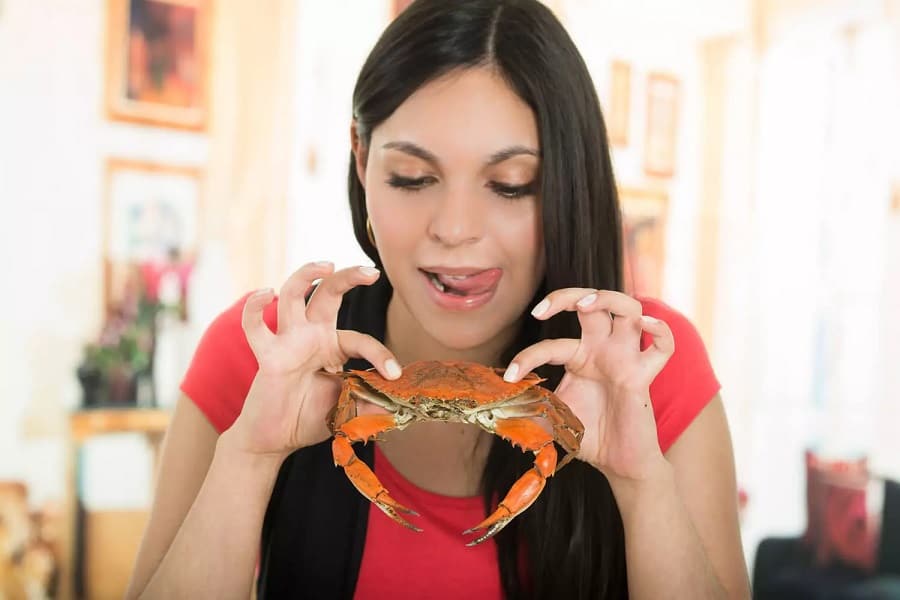
Table of Contents
Introduction
Pregnancy is a special time in a woman’s life, and it comes with various dietary considerations. One question that often arises is ‘Can you eat crab while pregnant?’ Seafood, including crab, is a rich source of nutrients like omega-3 fatty acids and protein, but it can also harbor contaminants that may pose risks to the developing fetus.
In this blog, we’ll explore the benefits and potential risks associated with eating crab during pregnancy and offer guidelines to ensure safe consumption.
The Benefits of Crab Consumption During Pregnancy
Crab is a popular seafood choice due to its delicious taste and nutritional content. When consumed in moderation, the crab can be a valuable addition to a pregnant woman’s diet, providing the following benefits:
1. Protein: Crab is a great source of high-quality protein, essential for tissue repair, muscle development, and overall growth.
2. Omega-3 Fatty Acids: Omega-3 fatty acids found in crabs are crucial for the development of the baby’s brain and eyes.
3. Vitamins and Minerals: Crab contains vitamins and minerals such as vitamin B12, copper, selenium, and zinc, which play vital roles in supporting a healthy pregnancy.
Potential Risks and Concerns:
While crabs can be beneficial, it’s important to be aware of potential risks associated with their consumption during pregnancy:
1. Mercury Contamination: Some species of crab may contain elevated levels of mercury, which can harm the developing nervous system of the baby.
2. Bacterial Contamination: Crab, like all seafood, can carry bacteria that may cause foodborne illnesses, leading to complications during pregnancy.
3. Allergies: Pregnant women who are allergic to shellfish should avoid crabs and other crustaceans to prevent allergic reactions.
Safe Crab Consumption Guidelines during Pregnancy
To enjoy crab safely during pregnancy, consider the following guidelines:
1. Choose Low-Mercury Options: Opt for crab species that are low in mercury, such as blue crab, Alaskan king crab, and Dungeness crab. Avoid high-mercury species like king mackerel, shark, and tilefish.
2. Ensure Proper Cooking: Thoroughly cook crab meat to an internal temperature of 145°F (63°C) to eliminate harmful bacteria and parasites. Avoid consuming raw or undercooked crab.
3. Moderation is Key: Consume crab in moderation to minimize the risk of mercury exposure. Balance your diet with a variety of other protein sources.
4. Avoid Cross-Contamination: Handle crab and other seafood carefully to avoid cross-contamination with other foods, especially if you have allergies or are at risk of foodborne illnesses.
5. Listen to Your Body: If you experience any adverse reactions after eating crabs, such as itching, hives, or difficulty breathing, seek medical attention immediately.
As with any dietary decision during pregnancy, it’s crucial to consult your healthcare provider before adding crab to your diet. They can assess your individual health status, allergies, and dietary needs to provide personalized advice.
Surprise Takeaway! What seafood can't you eat while pregnant?
After a deep understanding of ‘Can you eat crab while pregnant?’ Let’s also know the other seafood you can’t eat while pregnant.
During pregnancy, certain types of seafood should be avoided due to potential risks associated with their consumption. These seafood items may contain high levels of mercury or other harmful contaminants that could negatively impact the developing fetus. Here are some types of seafood that pregnant women are generally advised to avoid:
- Shark: Shark is known to contain high levels of mercury, which can harm the baby’s nervous system.
- Swordfish: Similar to sharks, swordfish contains high mercury levels and should be avoided during pregnancy.
- King Mackerel: King mackerel is another fish that can have high mercury content and is best avoided by pregnant women.
- Tilefish: Tilefish are known to have high mercury levels and should not be consumed during pregnancy.
- Marlin: Marlin is a type of fish with elevated mercury levels and is not recommended for pregnant women.
- Orange Roughy: Orange roughy is a deep-sea fish that tends to accumulate mercury, making it unsuitable for pregnant women.
- Bigeye Tuna: Bigeye tuna is a species of tuna that can have higher mercury levels, and it’s best to avoid it during pregnancy.
While these seafood items are generally advised against during pregnancy due to their mercury content, other types of fish and seafood can still be enjoyed in moderation. Low-mercury seafood options, such as shrimp, salmon, catfish, pollock, cod, and light canned tuna, can be safely consumed during pregnancy, as long as they are properly cooked.
To ensure a safe and healthy pregnancy, it’s crucial to follow guidelines from healthcare providers and nutritionists regarding seafood consumption. Always consult with your healthcare provider before making any significant changes to your diet during pregnancy to ensure the well-being of both you and your baby.
Conclusion :
In conclusion, eating crab during pregnancy can be safe and beneficial if certain precautions are followed. While crab is a valuable source of protein, omega-3 fatty acids, and essential nutrients, it’s essential to choose low-mercury options and ensure proper cooking to minimize potential risks.









